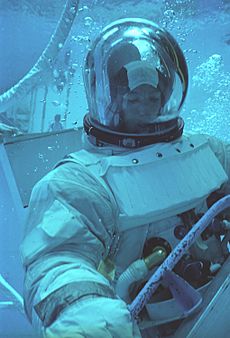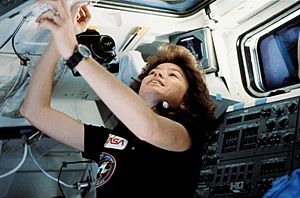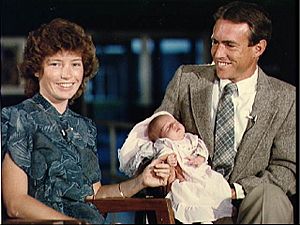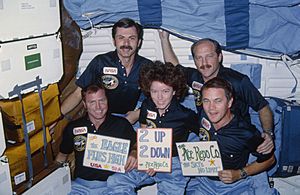Anna Lee Fisher facts for kids
Quick facts for kids
Anna Fisher
|
|
|---|---|

Fisher in 2002
|
|
| Born |
Anna Lee Tingle
August 24, 1949 Albany, New York, U.S.
|
| Awards |
|
| Space career | |
| NASA astronaut | |
|
Time in space
|
7d 23h 45m |
| Selection | NASA Group 8 (1978) |
| Missions | STS-51-A |
|
Mission insignia
|
|
Anna Lee Fisher (born August 24, 1949) is an American chemist, emergency room doctor, and a former NASA astronaut. In 1984, she made history by becoming the first mother to travel to space.
During her long career at NASA, Fisher worked on three major space programs. These were the Space Shuttle, the International Space Station, and the Orion spacecraft.
Fisher studied at the University of California, Los Angeles (UCLA). She earned a degree in chemistry and later became a medical doctor. She chose to work in emergency medicine, helping people in urgent medical situations.
In 1978, Fisher was chosen to be an astronaut. She was part of the first group of NASA astronauts that included women. She helped test the Canadarm, a robotic arm used on the Space Shuttle. She also flew on the Space Shuttle Space Shuttle Discovery for the STS-51-A mission in 1984. On this mission, she used the Canadarm to help retrieve two satellites from orbit.
Contents
Early Life and Schooling
Anna Lee Tingle was born in Albany, New York, on August 24, 1949. Her father was in the U.S. Army, so her family moved often. She grew up on military bases in the United States and Germany and learned to speak German.
When Anna was in the seventh grade, her teacher brought a radio to class. They listened as Alan Shepard became the first American in space. This moment inspired her to dream of becoming an astronaut. At the time, all astronauts were male military test pilots. But she hoped that one day, space stations would need doctors.
She graduated from San Pedro High School in 1967 and went to UCLA. She first studied math but then switched to chemistry. She earned her Bachelor of Science degree in 1971. After college, she decided to become a doctor. She went to the UCLA School of Medicine and earned her medical degree in 1976. She then trained to become an emergency room doctor.
Becoming a NASA Astronaut
Joining NASA
In 1977, NASA announced it was looking for new astronauts, including doctors and women. Anna and her fiancé, Bill Fisher, who was also a doctor, both applied. They had to send in their applications quickly. Just a week before her interview at NASA's Johnson Space Center, she and Bill got married.
Anna was accepted into the astronaut program in January 1978. She was part of a group of 35 new astronauts called NASA Astronaut Group 8. This group was nicknamed "TFNG," which stood for "Thirty-Five New Guys." It was the first group to include women and minority astronauts. Her husband Bill was not selected at first, but he joined NASA in a later group. This made them the first married couple to be chosen as astronauts.
Training to Fly in Space
The new astronaut candidates started with a lot of classroom learning. They also had to complete tough physical training. This included water survival drills and learning to fly in NASA's T-38 Talon jet aircraft. Even though she was a mission specialist and not a pilot, she had to know how to handle the jet in an emergency.
Fisher also helped design spacesuits for women. She tried on an old Apollo spacesuit, but it was too big. She then worked on developing emergency repair methods for the Space Shuttle's heat-shield tiles. She also became an expert on the Canadarm robotic arm.
For the first four Space Shuttle missions, Fisher was part of the search and rescue helicopter teams. Her job was to help if the shuttle had to make an emergency landing. She also helped test the flight software for several missions.
First Mother in Space
Mission STS-51-A
In 1983, Fisher was chosen for a space mission. Around the same time, she gave birth to her first daughter, Kristin. This meant she would become the first mother to fly in space.
Her mission was STS-51-A aboard the Space Shuttle Space Shuttle Discovery. The main goal was very ambitious: to rescue two communication satellites that were stuck in the wrong orbit. This had never been done before. The satellites were not designed to be captured, so the crew had to come up with a special plan.
The plan involved using a special tool called a "stinger." An astronaut would fly out to the satellite using a jetpack called the Manned Maneuvering Unit (MMU). He would insert the stinger into the satellite's engine nozzle. Fisher would then use the Canadarm to grab the stinger and pull the satellite into the shuttle's cargo bay.
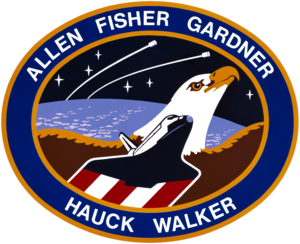
The mission launched on November 8, 1984. On the fifth day, the crew successfully captured the first satellite, Palapa B2. They had to change their plan in the middle of the spacewalk, but their teamwork paid off. The next day, they captured the second satellite, Westar VI.
The mission was a huge success. The crew of Discovery returned to Earth on November 16, 1984. The flight lasted nearly eight days.
Later Career at NASA
After the Challenger disaster in 1986, all shuttle flights were stopped for a time. Fisher worked in different roles at NASA. She helped develop procedures for future missions and served on the astronaut selection board.
From 1989 to 1995, Fisher took a long break from NASA to raise her two daughters. She returned to the Astronaut Office in 1995 and began working on the International Space Station (ISS) program. She helped plan the operations and training for the astronauts who would live and work on the station.
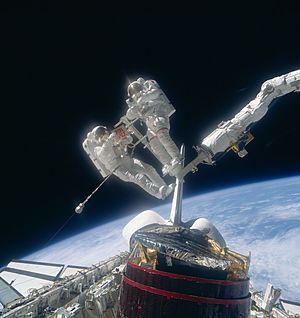
Later, she served as a capsule communicator (CAPCOM), the astronaut in mission control who speaks directly to the crew in space. She was the lead CAPCOM for ISS Expedition 33. Her final job at NASA was helping to develop the displays for the new Orion spacecraft, which is designed for future missions to the Moon and beyond.
Anna Fisher retired from NASA in April 2017, after a remarkable career that spanned nearly four decades.
Images for kids
-
Fisher with U.S. Secretary of Commerce Wilbur Ross (center) and diplomat William W. Popp in 2019
-
Fisher visiting the building where the Orion spacecraft for the Exploration Flight Test-1 mission was being prepared
See also
 In Spanish: Anna Lee Fisher para niños
In Spanish: Anna Lee Fisher para niños



